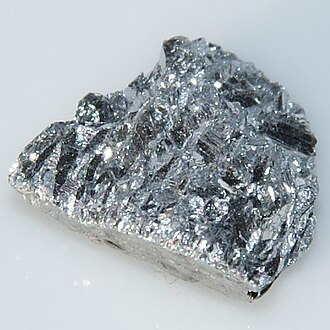Pronunciation Appearance silvery lustrous gray Standard atomic weight (A r, standard ) [1]
Atomic number (Z ) 51 Group group 15 (pnictogens) Period period 5 Block p-block Element category metalloid Electron configuration [Kr ] 4d10 5s2 5p3 Electrons per shell
2, 8, 18, 18, 5 Phase at STP Sb: Solid Melting point 903.78 K (630.63 °C, 1167.13 °F) Boiling point 1908 K (1635 °C, 2975 °F) Density (near r.t. ) 6.697 g/cm3 when liquid (at m.p. ) 6.53 g/cm3 Heat of fusion 19.79 kJ/mol Heat of vaporization 193.43 kJ/mol Molar heat capacity 25.23 J/(mol·K) Vapor pressure
P (Pa)
1
10
100
1 k
10 k
100 k
at T (K)
807
876
1011
1219
1491
1858
Oxidation states −3 +3 +5 amphoteric oxide)Electronegativity Pauling scale: 2.05 Ionization energies 1st: 834 kJ/mol 2nd: 1594.9 kJ/mol 3rd: 2440 kJ/mol (more ) Atomic radius empirical: 140 pm Covalent radius 139±5 pm Van der Waals radius 206 pm Spectral lines of antimonyNatural occurrence Sb: Primordial Crystal structure rhombohedral Speed of sound thin rod 3420 m/s (at 20 °C) Thermal expansion 11 µm/(m·K) (at 25 °C) Thermal conductivity 24.4 W/(m·K) Electrical resistivity 417 nΩ·m (at 20 °C) Magnetic ordering diamagnetic [2] Magnetic susceptibility −99.0·10−6 cm3 /mol[3] Young's modulus 55 GPa Shear modulus 20 GPa Bulk modulus 42 GPa Mohs hardness 3.0 Brinell hardness 294–384 MPa CAS Number 7440-36-0 Discovery Arabic alchemists (before AD 815)
| references 

